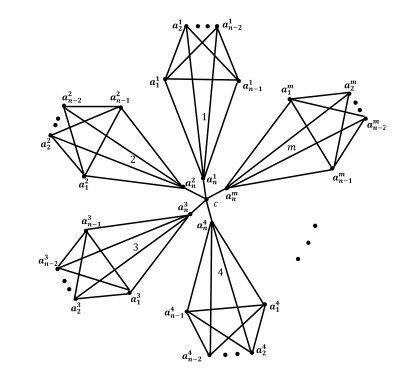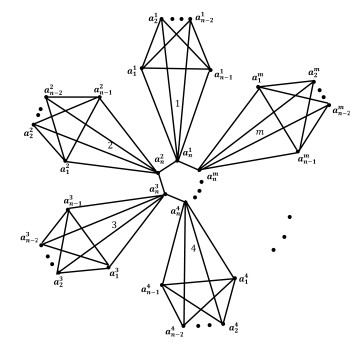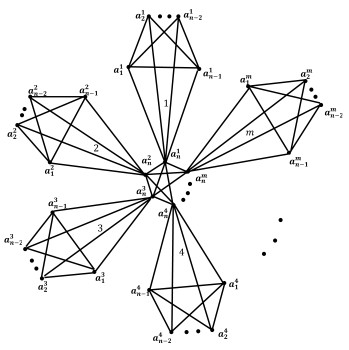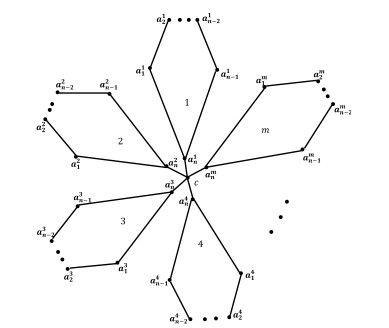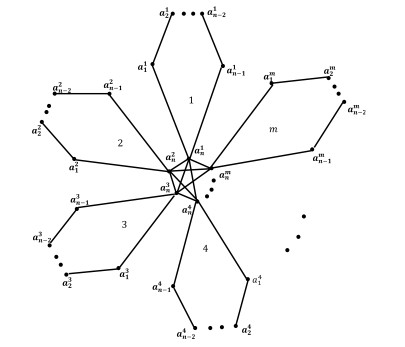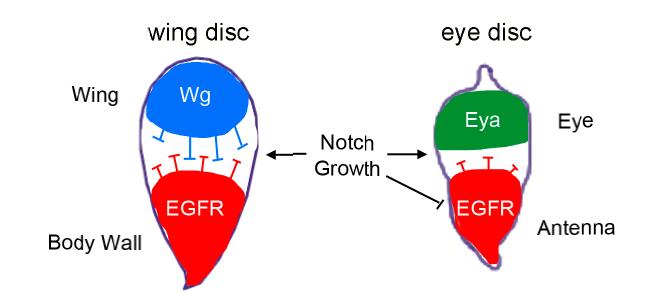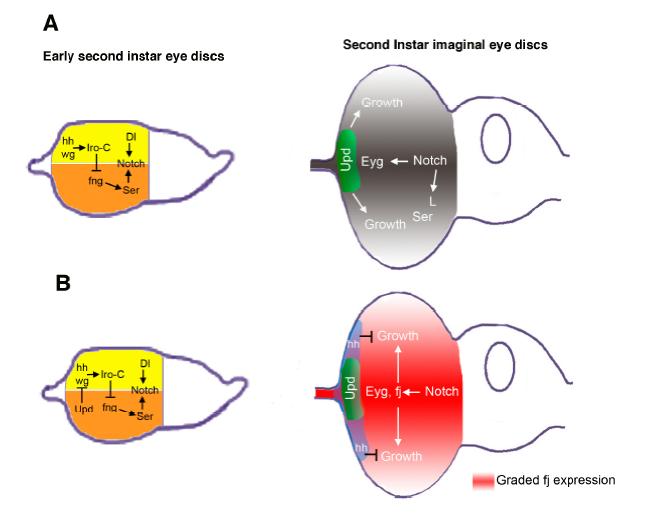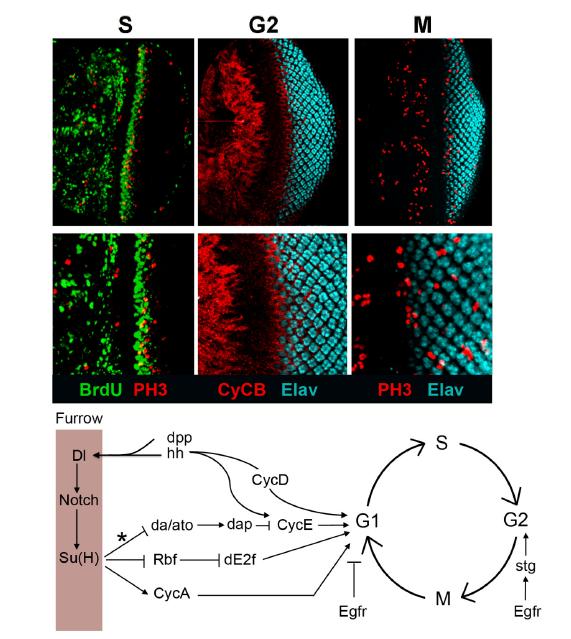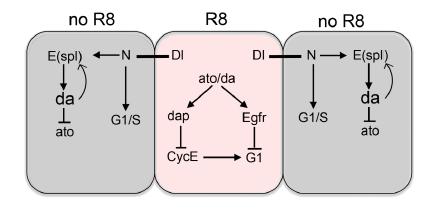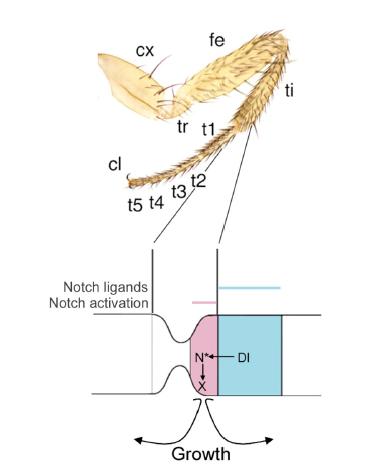The Notch signalling pathway is evolutionary conserved and participates in numerous developmental processes, including the control of cell proliferation. However, Notch signalling can promote or restrain cell division depending on the developmental context, as has been observed in human cancer where Notch can function as a tumor suppressor or an oncogene. Thus, the outcome of Notch signalling can be influenced by the cross-talk between Notch and other signalling pathways. The use of model organisms such as Drosophila has been proven to be very valuable to understand the developmental role of the Notch pathway in different tissues and its relationship with other signalling pathways during cell proliferation control. Here we review recent studies in Drosophila that shed light in the developmental control of cell proliferation by the Notch pathway in different contexts such as the eye, wing and leg imaginal discs. We also discuss the autonomous and non-autonomous effects of the Notch pathway on cell proliferation and its interactions with different signalling pathways.
1.
Introduction
In recent years, there is an increased demand for the application of mathematics. Graph theory has proven to be particularly useful to a large number of rather diverse fields. As a useful tool for dealing with relations of events, graph theory has rapidly grown in theoretical results as well as its applications to real-life problems. One concept that pervades all the graph theory is that of distance, and distance is used in isomorphism testing, graph operations, maximal and minimal problems on connectivity and diameter. Several parameters related to distances in graphs are highly attracting the attention of several researchers. One of them, namely, the metric dimension, has specifically centered several investigations.
The concept of metric dimension was introduced by Slater [23] in 1975 in which he used the term locating set in connection with some location problems in graphs. Harary and Melter [7] also studied the same concept and used the term resolving set. After these two pioneering papers, a lot of work on this invariant has been done concerning applications as well as theory. The families of graphs with constant metric dimensions have been characterized by many different authors, one can see [9,10]. There are a lot of variants of the standard metric dimension, such as local metric dimension, strong metric dimension, fractional metric dimension, fault-tolerant metric dimension and many more have been studied in [1,8,15,16,18]. In 2000, Chartrand et al. [3] determined all connected graphs of order $ n $ having metric dimension $ 1 $, $ n-1 $ or $ n-2 $. Some other interesting results on the metric dimension and references can be found in [5,11,17,19,21].
In 2018, the new parameter edge metric dimension has been introduced by Kelenc [12] in which they determined the value for wheel graphs and fan graphs. They studied that the wheel graphs of order $ n\geq 6 $ and the fan graphs of order $ n\geq 5 $ have edge metric dimension $ n-2 $. Nasir et al. [14] also determined the edge metric dimension for two families when $ G $ is an $ n $-sunlet graph and a prism graph. Zubrilina et al. [25] characterized the graphs for which the edge metric dimension of graphs is $ n-1 $. They also proposed an open problem: For which graphs $ G $ of order $ n $, the edge metric dimension is $ n-2 $? Recently, Wei et al. [24] gave the characterization of all connected bipartite graphs with edge metric dimension $ n-2 $, which partially answers an open problem of Zubrilina et al. [25]. They also investigated the relationship between the edge metric dimension and the clique number of a graph $ G $.
In this paper, we consider the problem of computing the metric dimension and edge metric dimension of windmill graphs and certain generalizations of these graphs. Applications of this optimization problem arise in diverse areas. See [3] for an application of this problem in pharmaceutical chemistry, [22] for coin weighing problem, [13] for robot navigation, [2] for network discovery and verification, [20] for connected joins in graphs, and [4] for strategies for the mastermind game. See [6] for an application of windmill graphs in networks.
A graph $ G = (V, E) $ is an ordered pair consisting of a nonempty set $ V = V(G) $ of elements called vertices and a set $ E = E(G) $ of unordered pairs of vertices called edges. For distinct vertices $ v_1 $ and $ v_2 $, the distance between $ v_1 $ and $ v_2 $, denoted by $ d(v_1, v_2) $, is the length of the shortest path connecting $ v_1 $ and $ v_2 $. Let $ d(v, e) $ denotes the distance between edge $ e $ and vertex $ v $, defined as $ d(v, e) = min\{d(v, a), d(v, b)\} $, where $ e = ab $. A vertex $ v $ distinguishes two edges $ e_1 $ and $ e_2 $, if $ d(e_1, v)\neq d(e_2, v) $. $ G $ is called a complete graph if every pair of vertices is joined by exactly one edge. A complete graph of order $ n $ is denoted by $ K_n $. A graph $ G $ with $ n $ vertices ($ n\geq 3 $) and $ n $ edges is called a cyclic graph if all its edges form a cycle of length $ n $. It is denoted by $ C_n $. $ G $ is a bipartite graph means that vertex sets can be partitioned into two subsets $ U $ and $ W $, called partite sets, such that every edge of $ G $ joins a vertex of $ U $ and a vertex of $ W $. If every vertex of $ U $ is adjacent to every vertex of $ W $, $ G $ is called a complete bipartite graph, where $ U $ and $ W $ are independent. A star graph is a complete bipartite graph in which $ (n-1) $ vertices have a degree $ 1 $ and a single vertex has a degree $ (n-1) $. It is denoted by $ S_n $.
Let $ R = \{r_1, r_2, \ldots, r_k\} $ be an ordered set of vertices of $ G $ and let $ v $ be a vertex of $ G $. The representation $ r(v|R) $ of $ v $ with respect to $ R $ is the $ k $-tuple $ (d(v, r_1), d(v, r_2), \ldots, d(v, r_k)) $. If distinct vertices of $ G $ have distinct representation with respect to $ R $, then $ R $ is called a resolving set for $ G $. A resolving set of minimum cardinality is a metric basis for $ G $, and its cardinality is called the metric dimension of $ G $, denoted by $ dim(G) $.
Let $ R_E = \{x_1, x_2, \ldots, x_k\} $ be an ordered set in $ V(G) $ and let $ e \in E(G) $. The representation $ r(e|R_E) $ of $ e $ with respect to $ R_E $ is the $ k $-tuple $ (d(e, x_1), d(e, x_2), ..., d(e, x_k)) $. If distinct edges of $ G $ have distinct representation with respect to $ R_E $, then $ R_E $ is called an edge metric generator for $ G $. An edge metric generator of minimum cardinality is an edge metric basis for $ G $, and its cardinality is called edge metric dimension of $ G $, denoted by $ edim(G) $.
Throughout this paper, the French star windmill graph is denoted by $ SW_n^m $, French cyclic windmill graph by $ CW_n^m $ and French complete windmill graph by $ KW_n^m $ wherein the shared vertex of French windmill graph ($ W_n^m $) is replaced by star graph, cyclic graph and complete graph respectively. We also denote the Dutch star windmill graph by $ SD_n^m $, Dutch cyclic windmill graph by $ CD_n^m $ and Dutch complete windmill graph by $ KD_n^m $ wherein the shared vertex of Dutch windmill graph ($ D_n^m $) is replaced by star graph, cyclic graph, and complete graph respectively.
2.
French windmill graph
In this section we discuss French windmill graph (see, Figure 1) and certain generalizations of this graph.
The French windmill graph, $ W_{n}^{m} $, $ n \geq3, m\geq2 $ is the graph obtained by taking $ m $ copies of the complete graph ($ K_n $) joined at a shared universal vertex. It has $ m(n-1)+1 $ vertices and $ mn(n-1)/2 $ edges. For our purpose, we denote the complete subgraphs of $ W_{n}^{m} $ by $ W_{n}^{i}, i = 1, 2, \ldots m $, the shared vertex by $ c $, the vertices of $ W_{n}^{i} $ by $ \{a_{1}^{i}, a_{2}^{i}, \ldots, a_{n-1}^{i}, c\} $, $ V_i, \ n^*, \ n^{**} $ by $ \{a_{1}^{i}, a_{2}^{i}, \ldots, a_{n-1}^{i}\} $, $ \underbrace{n, n, \ldots, n}_{ n-2 \text{ times}} $, $ \underbrace{n, n, \ldots, n}_{ n-1 \text{ times}} $ respectively.
In the following theorems, we compute the metric dimension and edge metric dimension of French windmill graph.
Theorem 2.1. The metric dimension of French windmill graph is $ m(n-2) $.
Proof. Let $ R $ be the resolving set of French windmill graph ($ W_{n}^{m} $). We can assume that there exist some $ x, y \in V_i $ for some $ i $, such that $ x, y \notin R $. Then $ r(x|R) = r(y|R) $, which is a contradiction. Now, let $ R_0 = \{a_{1}^{i}, a_{2}^{i}, \ldots, a_{n-2}^{i}\}, \ i = 1, 2, \ldots, m $. Representation of vertices of $ W_{n}^{m} $ with respect to $ R_0 $ are
Since there is no vertex having same representation, so $ R_0 $ is a resolving set of $ W_{n}^{m} $. Hence $ dim(W_{n}^{m}) = m(n-2) $.
Theorem 2.2. The edge metric dimension of French windmill graph is $ m(n-1)-1 $.
Proof. Let $ R_E $ be the edge metric basis of $ W_{n}^{m} $. We claim that it contains all vertices from $ \bigcup V_i $ except one. Suppose on the contrary that there exist $ x, y \in \bigcup V_i $ such that $ x, y \notin R_E $. We have two cases:
$ 1) $ when $ x \in V_i $ and $ y \in V_j $, then $ r(cx|R_E) = r(cy|R_E) $
$ 2) $ when $ x, y \in V_i $, then $ r(cx|R_E) = r(cy|R_E) $
which is a contradiction. Now, let $ R_{E}^{'} = \bigcup_{i}V_i \setminus \{a_{1}^{1}\} $. Representation of edges of $ W_{n}^{m} $ with respect to $ R_{E}^{'} $ are
Since there is no edge having same representation, so $ R_{E}^{'} $ is an edge metric generator of $ W_n^m $. Hence $ edim(W_{n}^{m}) = m(n-1)-1 $.
The following lemmas show that the metric dimension and edge metric dimension of generalizations of French windmill graph (discussed in this section) is at least $ m(n-2) $.
Lemma 2.3. The metric dimension of $ SW_n^m, \ CW_n^m, \ \mathit{\text{and}} KW_n^m $ is at least $ m(n-2) $.
Proof. We can assume that there exist some $ x, y \in V_i $ for some $ i $, such that $ x, y \notin R $. Then $ r(x|R) = r(y|R) $, which is a contradiction.
Lemma 2.4. The edge metric dimension of $ SW_n^m, \ CW_n^m, \ \mathit{\text{and}} KW_n^m $ is at least $ m(n-2) $.
Proof. We can assume that there exist $ x, y \in V_i $ for some $ i $, such that $ x, y \notin R_E $. Then $ r(a_{n}^{i}x |R_E) = r(a_{n}^{i}y |R_E) $, which is a contradiction.
2.1. French star windmill graph
Let $ SW_n^m $ be a graph obtained by replacing the shared vertex of French windmill graph with a star graph $ S_m $ (see, Figure 2). It has $ mn+1 $ vertices and $ \frac{mn(n-1)}{2} + m $ edges. For our sake, we denote the complete subgraphs of $ SW_n^m $ by $ W_{n}^{i} $ and its vertices as $ \{a_{1}^{i}, a_{2}^{i}, \ldots, a_{n-1}^{i}, a_{n}^{i}\} $. In the following results, we compute the metric dimension and edge metric dimension of this graph.
Theorem 2.5. The metric dimension of $ SW_n^m $ is $ m(n-2) $.
Proof. By Lemma 2.3, we have $ dim(SW_{n}^{m}) \geq m(n-2) $. Now, let $ R_0 = \{a_{1}^{i}, a_{2}^{i}, \ldots, a_{n-2}^{i}\}, \ i = 1, 2, \ldots, m $. Representation of vertices of $ SW_n^m $ with respect to $ R_0 $ are
Therefore $ R_0 $ is a resolving set of $ SW_n^m $. Hence $ dim(SW_n^m) = m(n-2) $.
Theorem 2.6. The edge metric dimension of $ SW_n^m $ is $ m(n-2) $.
Proof. By Lemma 2.4, we have $ edim(SW_n^m) \geq m(n-2) $. Now, let $ R_{E}^{'} = \{a_{1}^{i}, a_{2}^{i}, \ldots, a_{n-2}^{i}\}, \ i = 1, 2, \ldots, m $. Representation of edges of $ SW_n^m $ with respect to $ R_{E}^{'} $ are
which implies that $ edim(SW_n^m) \leq m(n-2) $. Therefore, $ edim(SW_n^m) = m(n-2) $.
2.2. French cycle windmill graph
Let $ CW_n^m $ be a graph obtained by replacing the shared vertex of French windmill graph with a cycle graph (see, Figure 3). It has $ mn $ vertices and $ \frac{mn(n-1)}{2} + m $ edges. For our sake, we denote the complete subgraphs of $ CW_n^m $ by $ W_{n}^{i} $ and its vertices as $ a_{1}^{i}, a_{2}^{i}, \ldots, a_{n-1}^{i}, a_{n}^{i} $. Now we determine the metric dimension and edge metric dimension of this graph.
Theorem 2.7. The metric dimension of $ CW_n^m $ is $ m(n-2) $.
Proof. Let $ R_0 = \{a_{1}^{i}, a_{2}^{i}, \ldots, a_{n-2}^{i}\}, \ i = 1, 2, \ldots, m $ and $ x_k = d(a_{n}^{i}|a_{n}^{k}) $. Then representation of vertices of $ CW_n^m $ are
It implies that $ dim(CW_n^m) \leq m(n-2) $. Also, from Lemma 2.3, we have $ dim(CW_n^m) \geq m(n-2) $. Therefore, $ dim(CW_n^m) = m(n-2) $.
Theorem 2.8. The edge metric dimension of $ CW_n^m $ is $ m(n-2) $.
Proof. Let $ R_{E}^{'} = \{a_{1}^{i}, a_{2}^{i}, \ldots, a_{n-2}^{i}\}, \ i = 1, 2, \ldots, m $. Representation of edges of $ CW_n^m $ with respect to $ R_{E}^{'} $ are as follows
where $ x_{k}^{'} = min\{(d(a_{n}^{i}|a_{n}^{k})), (d(a_{n}^{i+1}|a_{n}^{k})) $. It implies that $ edim(CW_n^m) \leq m(n-2) $. Also, from Lemma 2.4, we have $ edim(CW_n^m) \geq m(n-2) $. Therefore, $ edim(CW_n^m) = m(n-2) $.
2.3. French complete windmill graph
Let $ KW_n^m $ be a graph obtained by replacing the shared vertex of windmill graph with a complete graph $ K_m $ (see, Figure 4). It has $ mn $ vertices and $ \frac{mn(n-1)}{2} + \frac{m(m-1)}{2} $ edges. For our sake, we denote the complete subgraphs of $ KW_n^m $ by $ W_{n}^{i} $ and its vertices as $ a_{1}^{i}, a_{2}^{i}, \ldots, a_{n-1}^{i}, a_{n}^{i} $. Now we determine the metric dimension and edge metric dimension of this graph.
Theorem 2.9. The metric dimension of $ KW_n^m $ is $ m(n-2) $.
Proof. By Lemma 2.3, we have $ dim(KW_n^m) \geq m(n-2) $. Also, let $ R_0 = \{a_{1}^{i}, a_{2}^{i}, \ldots, a_{n-2}^{i}\}, \ i = 1, 2, \ldots, m $. Representation of vertices of $ KW_n^m $ with respect to $ R_0 $ are
which implies that $ R_0 $ is a resolving set and $ dim(KW_n^m) \leq m(n-2) $. Therefore, $ dim(KW_n^m) = m(n-2) $.
Theorem 2.10. The edge metric dimension of $ KW_n^m $ is $ m(n-2) $.
Proof. By Lemma 2.4, we have $ edim(KW_n^m) \geq m(n-2) $. Also, let $ R_{E}^{'} = \{a_{1}^{i}, a_{2}^{i}, \ldots, a_{n-2}^{i}\}, \ i = 1, 2, \ldots, m $, we claim that $ R_{E}^{'} $ is an edge metric generator of $ KW_n^m $. Representation of edges of $ KW_n^m $ with respect to $ R_{E}^{'} $ are
which implies that $ R_{E}^{'} $ is an edge metric generator and $ edim(KW_n^m) \leq m(n-2) $. Therefore, $ edim(KW_n^m) = m(n-2) $.
3.
Dutch windmill graph
In this section, Dutch windmill graph (see, Figure 5) and certain generalizations of this graph are discussed.
The Dutch windmill graph, $ D_{n}^{m} $, $ n \geq 3, m\geq 2 $ is the graph obtained by taking $ m $ copies of the cycle graph $ C_n $ joined at a shared universal vertex. It has $ m(n-1)+1 $ vertices and $ mn $ edges. For our purpose, we denote the cycle subgraphs of $ D_{n}^{m} $ by $ D_{n}^{i}, i = 1, 2, \ldots m $, the shared vertex by $ c $, and the vertices of $ D_{n}^{i} $ by $ a_{1}^{i}, a_{2}^{i}, \ldots, a_{n-1}^{i}, c $. In the following theorems, we compute the metric dimension and edge metric dimension of Dutch windmill graph.
Theorem 3.1. The metric dimension of Dutch windmill graph is:
Proof. $ 1) $. When $ n $ is odd: Let $ R $ be any resolving set of $ D_{n}^{m} $. Assume that there exist some $ V_i $ with no vertex in $ R $, then
which is a contradiction. Therefore, $ dim(D_{n}^{m}) \geq m $. Let $ R_0 = \{a_{\lceil \frac{n}{2} \rceil}^{i}\}, \ i = 1, 2, \ldots, m $. We have,
Representation of vertices of $ D_{n}^{m} $ with respect to $ R_0 $ are
Let $ a_{j_1}, a_{j_2}\in D_{n}^{m} $ be any two vertices, then we have the following cases:
Case 1. When the vertices belong to different sets, say $ V_i $ and $ V_k $, then $ r(a_{j_1}^{i}|R_0) \neq r(a_{j_2}^{k}|R_0) $
Case 2. When vertices belong to same sets, then we have two subcases
$ a) $ when $ j_1, j_2 < \lceil \frac{n}{2} \rceil (or > \lceil \frac{n}{2} \rceil) $ then $ r(a_{j_1}^{i}|R_0) \neq r(a_{j_2}^{i}|R_0) $
$ b) $ when $ j_1 < \lceil \frac{n}{2} \rceil, \ j_2 > \lceil \frac{n}{2} \rceil $. Suppose $ r(a_{j_1}^{i}|R_0) = r(a_{j_2}^{i}|R_0) $, then $ \lfloor \frac{n}{2} \rfloor + j_1 = n- j_2 + \lfloor \frac{n}{2} \rfloor $ and $ \lceil \frac{n}{2} \rceil - j_1 = j_2 - \lceil \frac{n}{2} \rceil $, which implies $ n = j_1 + j_2 $ and $ n = j_1 + j_2 - 1 $, which is a contradiction. Therefore $ r(a_{j_1}^{i}|R_0) \neq r(a_{j_2}^{i}|R_0) $ for all $ j_1, j_2 $. Since every vertex of $ D_{n}^{m} $ has unique representation with respect to $ R_0 $ which implies that $ dim(D_{n}^{m}) \leq m. $ Therefore, $ dim(D_{n}^{m}) = m $.
$ 2) $. When $ n $ is even: First, we claim that any resolving set $ R $ of $ D_{n}^{m} $ contains at least two vertices from each set $ V_i $ except one. Suppose on the contrary that there exist two sets say $ V_i $ and $ V_j $ with only one vertex in $ R $. Without loss of generality, suppose $ a_{1}^{i}, a_{1}^{j} \in R $, then $ r(a_{n-1}^{i}|R) = r(a_{n-1}^{j}|R) $, which is a contradiction. Therefore, $ dim(D_{n}^{m}) \geq 2m-1. $ Let $ R_0 = \{a_{1}^{1}, a_{1}^{2}, \ldots, a_{1}^{m}, a_{n-1}^{1}, a_{n-1}^{2}, \ldots, a_{n-1}^{m-1}\} $. We show that $ R_0 $ is resolving set of $ D_{n}^{m} $. Representation of vertices of $ D_{n}^{m} $ with respect to $ R_0 $ are
Let $ a_{j_1}, a_{j_2}\in D_{n}^{m} $ be any two vertices, then we have the following cases:
Case 1. When the vertices belong to different sets, say $ V_i $ and $ V_k $, then $ r(a_{j_1}^{i}|R_0) \neq r(a_{j_2}^{k}|R_0) $.
Case 2. When vertices belong to same sets, then we have two subcases:
$ a) $ when $ j_1, j_2 < \frac{n}{2} (or > \frac{n}{2}) $ then $ r(a_{j_1}^{i}|R_0) \neq r(a_{j_2}^{i}|R_0) $
$ b) $ when $ j_1 < \frac{n}{2}, \ j_2 > \frac{n}{2} $. Suppose $ r(a_{j_1}^{i}|R_0) = r(a_{j_2}^{i}|R_0) $, then $ j_1 - 1 = n - j_2 +1 $ and $ j_1+1 = n-j_2 + 1 $ which implies $ n = j_1 + j_2 $ and $ n = j_1 + j_2-2 $, which is a contradiction. Therefore, $ r(a_{j_1}^{i}|R_0) \neq r(a_{j_2}^{i}|R_0) $ for all $ j_1, j_2 $. Since every vertex of $ D_{n}^{m} $ has unique representation with respect to $ R_0 $ which implies that $ dim(D_{n}^{m}) \leq 2m-1. $ Therefore, $ dim(D_{n}^{m}) = 2m-1 $.
Theorem 3.2. The edge metric dimension of $ D_{n}^{m} $ is $ 2m-1 $.
Proof. Assume that there exist two sets say $ V_i $ and $ V_j $ with only one vertex in $ R_E $. Without loss of generality, suppose $ a_{1}^{i}, a_{1}^{j} \in R_E $. Then $ r(a_{n-1}^{i}a_{n}^{i}|R_E) = r(a_{n-1}^{j}a_{n}^{j}|R_E) $, which is a contradiction. Therefore $ edim(D_{n}^{m}) \geq 2m-1. $ Let $ R_{E}^{'} = \{a_{1}^{1}, a_{1}^{2}, \ldots, a_{1}^{m}, a_{n-1}^{1}, a_{n-1}^{2}, \ldots, a_{n-1}^{m-1}\} $. We show that $ R_{E}^{'} $ is an edge metric generator of $ D_{n}^{m} $. Representation of edges of $ D_{n}^{m} $ with respect to $ R_{E}^{'} $ are
When $ n $ is odd:
When $ n $ is even:
Therefore, $ edim(D_{n}^{m}) = 2m-1 $.
The following two lemmas show that the metric dimension and edge metric dimension of generalizations of Dutch windmill graph (as discussed in this section) is at least $ m $.
Lemma 3.3. The metric dimension of $ SD_n^m, \ CD_n^m, \ \mathit{\text{and}} KD_n^m $ is at least $ m $.
Proof. We can assume that there exist some $ V_i $ with no vertex in $ R $, then $ r(a_{1}^{i}|R) = r(a_{n-1}^{i}|R) $, which is a contradiction.
Lemma 3.4. The metric dimension of $ SD_n^m, CD_n^m, $ and $ KD_n^m $ is at least $ m $.
Proof. We can assume that there exist a set $ V_i $ with no vertex in $ R_E $, then $ r(a_{n-1}^{i}a_{n}^{i}|R_E) = r(a_{1}^{i}a_{n}^{i}|R_E) $, which is a contradiction. Therefore, $ edim(SD_n^m) \geq m. $
3.1. Dutch star windmill graph
Let $ SD_n^m $ be a graph obtained by replacing the shared vertex of Dutch windmill graph with a star graph $ S_m $ (see, Figure 6). It has $ mn+1 $ vertices and $ m(n+1) $ edges. For our purpose, we denote the cycle subgraphs of $ SD_n^m $ by $ D_{n}^{i} $, its vertices by $ a_{1}^{i}, a_{2}^{i}, \ldots, a_{n-1}^{i}, a_{n}^{i} $ and vertices of $ S_m $ by $ a_{n}^{1}, a_{n}^{2}, \ldots, a_{n}^{m}, c $. In the following results, we discuss the metric dimension and edge metric dimension of this graph.
Theorem 3.5. The metric dimension of $ SD_n^m $ is $ m $.
Proof. By Lemma 3.3, we have $ dim(SD_n^m) \geq m $. Also, let $ R_0 = \{a_{1}^{i}\}, \ i = 1, 2, \ldots, m $. We claim that $ R_0 $ is a resolving set of $ SD_n^m $. Now,
Representation of vertices of $ SD_n^m $ with respect to $ R_0 $ are:
Clearly, we have $ dim(SD_n^m) \leq m $. Therefore, $ dim(SD_n^m) = m $.
Theorem 3.6. The edge metric dimension of $ SD_n^m $ is $ m $.
Proof. By Lemma 3.4, we have $ edim(SD_n^m) \geq m $. Also, let $ R_{E}^{'} = \{a_{1}^{i}\}, \ i = 1, 2, \ldots, m $. We claim that $ R_{E}^{'} $ is an edge metric generator of $ SD_n^m $. Representation of edges of $ SD_n^m $ with respect to $ R_{E}^{'} $ are:
Clearly, we have $ edim(SD_n^m) \leq m $. Hence $ edim(SD_n^m) = m $.
3.2. Dutch cycle windmill graph
Let $ CD_n^m $ be a graph obtained by replacing the shared vertex of Dutch windmill graph with a cycle graph ($ C_m $) (see, Figure 7). It has $ mn $ vertices and $ m(n+1) $ edges. For our sake, we denote the cycle subgraphs of $ CD_n^m $ by $ D_{n}^{i} $ and its vertices as $ a_{1}^{i}, a_{2}^{i}, \ldots, a_{n-1}^{i}, a_{n}^{i} $. Now, we determine the metric dimension and edge metric dimension of this graph.
Theorem 3.7. The metric dimension of $ CD_n^m $ is $ m $.
Proof. By Lemma 3.3, we have $ dim(CD_n^m) \geq m $. Also, let $ R_0 = \{a_{1}^{i}\}, \ i = 1, 2, \ldots, m $. We show that $ R_0 $ is a resolving set of $ CD_n^m $. Now,
where $ x_k = d(a_{n}^{i}|a_{n}^{k}) $. Representation of vertices with respect to $ R_0 $ are
Since every vertex of $ CD_n^m $ has unique representation with respect to $ R_0 $. Therefore, $ dim(CD_n^m) \leq m $. Hence, $ dim(CD_n^m) = m $.
Theorem 3.8. The edge metric dimension of $ CD_n^m $ is $ m $.
Proof. By Lemma 3.4, we have $ edim(CD_n^m) \geq m $. Also, let $ R_{E}^{'} = \{a_{1}^{i}\}, \ i = 1, 2, \ldots, m $. Representation of edges of $ CD_n^m $ with respect to $ R_{E}^{'} $ are
where $ x_k = min\{d(a_{n}^{i}|a_{n}^{k}), d(a_{n}^{i+1}|a_{n}^{k})\}, k = 1, 2, \ldots m $. Clearly, representation of every edge of $ CD_n^m $ with respect to $ R_{E}^{'} $ is different. Therefore, $ edim(CD_n^m) \leq m $. Hence $ edim(CD_n^m) = m $
3.3. Dutch complete windmill graph
Let $ KD_n^m $ be a graph obtained by replacing the shared vertex of Dutch windmill graph with a complete graph($ K_m $) (see, Figure 8). It has $ mn $ vertices and $ mn + \frac{m(m-1)}{2} $ edges. For our sake, we denote the cycle subgraphs of $ KD_n^m $ by $ D_{n}^{i} $ and its vertices as $ a_{1}^{i}, a_{2}^{i}, \ldots, a_{n-1}^{i}, a_{n}^{i} $. Now, we obtain the metric dimension and edge metric dimension of this graph.
Theorem 3.9. The metric dimension of $ KD_n^m $ is $ m $.
Proof. Let $ R_0 = \{a_{1}^{i}\}, \ i = 1, 2, \ldots, m $. Representation of vertices of $ KD_n^m $ with respect to $ R_0 $ are
which implies that $ R_0 $ is a resolving set and $ dim(KD_n^m) \leq m $. Also, from Lemma 3.3, $ dim(KD_n^m) \geq m $. Therefore, $ dim(KD_n^m) = m $.
Theorem 3.10. The edge metric dimension of $ KD_n^m $ is $ m $.
Proof. Let $ R_{E}^{'} = \{a_{1}^{i}\}, \ i = 1, 2, \ldots, m $. We claim that $ R_{E}^{'} $ is an edge metric generator of $ KD_n^m $. Representation of edges of $ KD_n^m $ with respect to $ R_{E}^{'} $ are
which implies that $ edim(KD_n^m) \leq m $. Also from Lemma 3.4, $ edim(KD_n^m) \geq m $. Hence $ edim(KD_n^m) = m $.
4.
Conclusions and future work
In this paper we have computed the metric dimension and edge metric dimension of French windmill and Dutch windmill graphs wherein the shared vertex is replaced by star graph, cyclic graph and complete graph. We have found that the metric dimension and edge metric dimension of generalizations of French windmill graph and Dutch windmill graph are same. In future, we would extend our work to Fault-tolerant metric dimension and Fractional metric dimension of French windmill and Dutch windmill graphs.
Conflict of interest
The authors declare no conflict of interest.
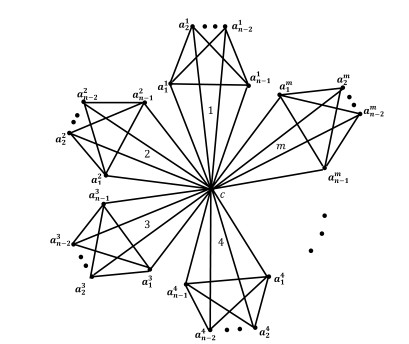









 DownLoad:
DownLoad:
